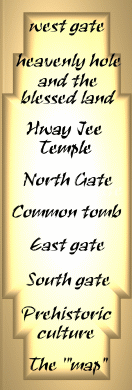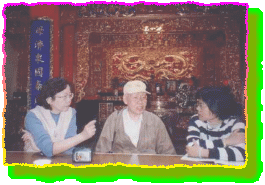
interview with the elders

[journals] [interview with the
elders]
[interviews with the tourists] [photographs]
[drawings]
[thoughts]
interviewee:Mr.Shee
interviewer: Mr.Hsu, Ms.Tung
 Q
: Some
say that the south gate in above 120 steps; some say it is in the middle.
Which is true? Why tear it
down?
Q
: Some
say that the south gate in above 120 steps; some say it is in the middle.
Which is true? Why tear it
down?
A : It's about in the
middle. They tore it down because both of its old age, and also because
120 steps was under reconstruction at the time.
Q
: Japanese
was originally taught in Hway Jee Temple; then it changed to
teaching Chinese. How many students attended? What were
their teachings?
A
: Actually,
the Japanese didn't strictly enforce students to learn
Japanese. They also held Chinese classes, and later other
courses such as Physical Education and music as well.
Q : "Mr.Six"
were just six grade school teachers. Why did they earn such
respect from the Japanese government?
A
: They
were college professors with a purpose to compile teaching
materials.
It wasn't easy to recruit teacher to Taiwan at first, and their accident may have made it even tougher, so they needed to be very careful with their deaths; also, the Japanese respect education to begin with. In addition the temple not only worshipped Japanese teachers, but Taiwanese educators as well. ( Mr.Shee's grandfather was a student of Mr.Six's. He taught him Japanese, while Shee's grandfather taught him Taiwanese.)
Q
: What
is now Yu-Nong Road was a trail in the past, and you mentioned in
your book that fifth and six graders built it, and kids today are
very curious about that,could you tell us more?
A : Yes,
it used to be called the Chee-Shan Temple Trail; after the road was
bought, there was no budget, and thus students took turns cleaning
and building it.
I was a six grader then, and I participated in the engineering. I remember it was a pebble road.
In my days, it was important to participate in public affairs, and we must clean, farm, build roads, something that seems almost impossible to students today, but it was actually quite common in my days.
Q : Is
the old street of Chin Shan Rock near what is now the God of Farmers'
Temple? Because it's a long distance between the two, and students must
walk to school, is it too far?
A : Yes, it is close. People nowadays have cars as a means of
transportation, and can't stand even a little walk. But in the Japanese
era, people did not have so many cars, so it's quite nothing for them to walk
like that.
Q
:
We heard that in this area many scholars were born. Is that
true?
A :
It's
a fact. There once lived a Mr.Pan who built school and offered free
classes for everybody, thus many scholars came from this area.
Later, Mr.Yang continued his legacy. This tells us the importance of education in a community or even country, I think.
Q
: Mr.Shee,
you lived under both the Japanese reign and the current government,
what is the difference in Chee-Shan Rock in these two periods?
A :
In the Japanese era, they set up schools here. It is an
undeniable fact that the Japanese really valued education above all
others, and because they knew about Mr.Pan and his previous work
here, and that's why they chose this place. For a long time,
this area is like a holy place for all educators to come and
worship.
After we defeated the Japanese, they still set up a Shih-Lin organization back in Japan, to memorialize Shih-Lin Elementary School, and students here will also go to Japan to visit their old teachers. Under the current government, Chee-Shan Rock became a type of military place, and so normal civilians would not come to this place until recent years when it was open to the public. So I would say that the atmosphere has shifted to a somewhat mysterious type.
Q : Why
did they keep the canon and the watch posts? They look out of place.
A : I supported keeping
them. That way we get to keep a part of history and leave things for
future generations to see.
Q : You
mentioned in your book that there is a small trail to East Gate. Have
you seen East Gate?
A : No, but I've been
on this trail a couple of times. It could lead straight to Yang Ming
Hospital; I also saw the wooden bars of the old East Gate ( it's probably
buried underground now ); the four gates were built about 180 years ago.
Q : Where
is the stonehorse?
A : It is right under
what is now 120 steps. You used to be able to see the limbs, but now
everything is almost entirely buried underground, so all that's left is a
little head and some body. It used to be farmland, but later on road
construction took place, which made what used to be groundlevel seem like it
is underground.
Q : Where
is the "four treasures of the study"?
A : If you go along the
north gate trail, you would see the "book, paper, and pen."
The pen is now in StoneGod Temple.
![]()

![]()
![]()
![]()

![]()